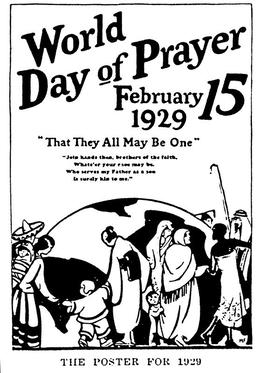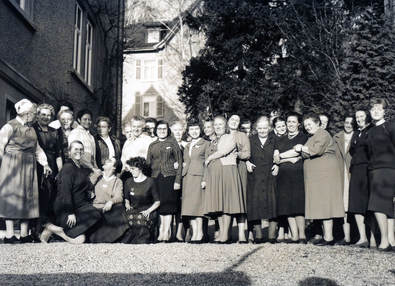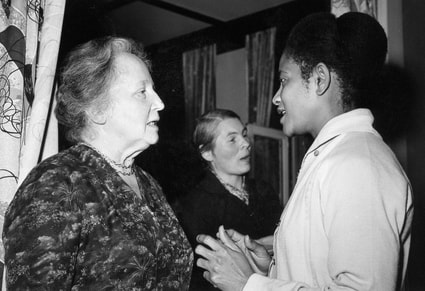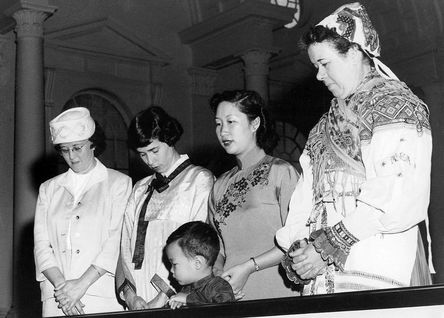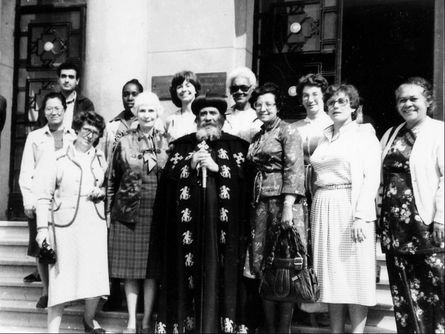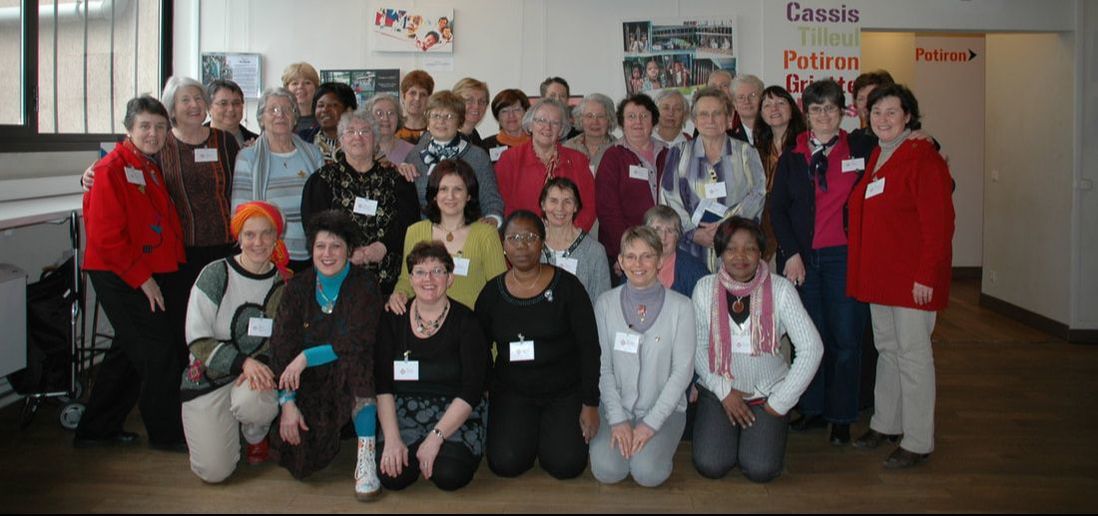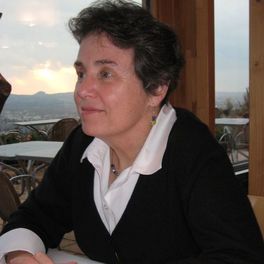The Story of the International Committee for World Day of Prayer
How it Came into Being -- How it Works Today
1927 - 1968 – 2018
By Eileen King and Helga Hiller
|
When we reflect on a birthday or anniversary, we begin with the importance of a number, like the 50th anniversary of the formation of the World Day of Prayer International Committee. The anniversary becomes an opportunity to re-examine how it all began and how we got to where we are now. It is also a chance to consider how the past is linked to the present. For example, last year, in August of 2017, the World Day of Prayer International Committee met in Brazil. How did the 2017 International Meeting of 188 WDP delegates representing WDP in 81 countries come into existence? This 50th anniversary provides an occasion to understand how something that exists now took its shape back then.
When we were asked to write the story of the WDP International Committee, we had a double task: to go back to historical records minutes, WDP services and reports, and at the same time form them into a narrative for WDP women that lead us to what is WDP today. We did research and writing that was not done before. The records themselves helped us by offering vivid impressions. However, because we had to be short and the time period to cover was long, we had to merge steps and to focus on the most important events. We regret that we had to leave out the names of many women that shaped our history in a special way. Nonetheless, the story of WDP is above all the story of millions of unnamed women that carried the movement then and do it today. The WDP story stretches from the vision of a World Committee and of shared responsibility that dates back almost to the beginning of WDP and arrives at what is the World Day of Prayer International Committee today. |
Starting Point:
|
Longing for Peace: WDP Grows,
Despite War and Worldwide Post War Depression
|
It took another 30 years, until the WDP movement was able to establish an International Committee that was entrusted with the responsibility for the administration, organization and growth worldwide. The years between 1938 and 1968, however, were not wasted. It was almost a miracle that WDP survived during World War II in a number of countries in the midst of oppression and destruction - that the services could still be spread worldwide and that WDP even grew enormously in countries like the United States, Canada, and England. The worship services during World War II give witness to the deep longing of Christian women for peace and reconciliation so that the deep wounds could eventually heal. This was even truer after the war, when women in many more countries - welcomed and supported by the WDP-Committee in New York - joined the Day of Prayer, grateful to become part of a world community of women that prayed for peace and renewal.
|
Amazing Stewardship of American Women in
Nurturing and Distributing WDP Services Worldwide
You may ask: How were WDP themes and writers chosen in those years? How were the WDP worship services distributed around the world? This is a story of amazing stewardship: Until the mid-1960s, the United Council of Church Women [UCCW] in the United States, through its WDP Committee, chose themes and writers from around the world. They worked in cooperation with Canadian women and with women from around the world who lived in North America. UCCW distributed the materials in the USA, also through many denominational channels, to local groups. The Day was loved and nurtured. In 1961 for instance, 22,000 communities in the USA celebrated WDP.
The Division of Foreign Missions, on its part, distributed the WDP-services “overseas” and collected reports from around the world. The women at the Foreign Mission Conference also combined love for the Day with their knowledge and understanding of women of other countries and with their worldwide connections. By the mid-1960s, they sent the service to around 1,000 addresses in about 145 countries. Today, we can hardly imagine how all this work was carried out only through mail and an amazing amount of correspondence.
The Division of Foreign Missions, on its part, distributed the WDP-services “overseas” and collected reports from around the world. The women at the Foreign Mission Conference also combined love for the Day with their knowledge and understanding of women of other countries and with their worldwide connections. By the mid-1960s, they sent the service to around 1,000 addresses in about 145 countries. Today, we can hardly imagine how all this work was carried out only through mail and an amazing amount of correspondence.
Fresh Start for Forming an International Committee
The new dimensions that made the foundation of an international WDP Committee in 1968 possible were expressed by one of the American women leaders in 1964: “Since this has been a Day that has been observed on a truly worldwide scale for 40 years, the rest of the world should have a part in deciding its course. Modern means of communication and travel now make it possible for us to come together to plan.”
Since the 1950s, more women were able to travel long distances and even overseas. They were deeply impressed by the experience of meeting women face to face with whom they had been praying and sharing concerns for many years. The breakthrough to enabling many women from around the globe to share in such an overwhelming experience happened in February 1961.
Since the 1950s, more women were able to travel long distances and even overseas. They were deeply impressed by the experience of meeting women face to face with whom they had been praying and sharing concerns for many years. The breakthrough to enabling many women from around the globe to share in such an overwhelming experience happened in February 1961.
1961 Prayer Fellowships in Five Continents
|
In an unheard-of joint effort of preparation, the United Council of Church Women together with Canadian women and women from other continents organized 37 Prayer Fellowships on five continents involving nearly 2,000 women from 80 countries. Every meeting closed with the women participating in WDP services in the host community or country. In the United States 29 Prayer Fellowships took place, 3 in Canada, and the other 5 were held in Kitwe (Africa), Hong Kong (East Asia), Madras (South Asia and Near East), Zürich (Europe) and Lima (Latin America). Every Prayer Fellowship was led by a denominationally and ethnically diverse team of women from the USA, the respective continent and other continents. It is impossible here to describe the overwhelming experiences of thankfulness and joy in getting to know each other, of togetherness in the midst of many divisions and conflicts and of uniting in prayer. The report from South Asia may convey some of the experience: “There was also an element of surprise in the reality of the meeting itself. This was the first time that church women from all parts of India had come together for fellowship and consultation.”
|
The task identified and taken up by the American women was above all to listen: to the concerns and issues the women raised and to their suggestions for future women’s work and most of all for WDP. Some of the suggestions for WDP were: keep prayer, information (also about the writer country) and action together, include bible studies, and include Catholic and Orthodox women. The American women also brought home the experience of how important it can be to collect funds for bringing women together worldwide and even sometimes to designate part of the WDP offering for this.
The evaluation of the Prayer Fellowships was followed in the next years by invitations to women from abroad to several important planning meetings in the USA. The years 1967 and 1968 then became crucial for what is today the WDP International Committee. Two major women’s conferences that took place in 1967 moved the WDP movement to a new level ecumenically and internationally. |
International Conferences Prepare the Formation of the International Committee for World Day of Prayer - 1967 International Ecumenical Conference, Taizé, France
|
From June 19 – 24, 1967, ninety-one women, among them forty-three Roman Catholic women, met in Taizé, France, for an International Ecumenical Conference on the theme “The Christian woman, co-artisan in a changing society”.
They were invited by the Conference of Catholic International Organizations in cooperation with the World Union of Catholic Women’s Organizations (WUCWO) and by the World Council of Churches in cooperation with the World Young Women`s Christian Association (World-YWCA). During the winter of 1966-67 a questionnaire had been widely distributed to women’s groups and organizations worldwide. The answers also reflected the amazing development of WDP in many countries after the Second Vatican Council (1962-65): “Most answers show that the World Day of Prayer is almost everywhere observed… and that it is an important element in ecumenical cooperation. Since, in an increasing number of countries, Roman Catholic women also take part in the services and their preparation, the question arises whether we ought to seek a joint day and a joint theme.” The final report stresses “the importance of praying together and of seizing every existing opportunity to do so (such as the Week of Prayer for Christian Unity and the Women’s World Day of Prayer), as well as discovering new occasions related to everyday life and current events.” |
1967 Worldwide Consultation in Anderson, Indiana, USA
Forming a Provisional WDP Executive Committee
 WDP Women in La Paz, Bolivia, in the 1950s
WDP Women in La Paz, Bolivia, in the 1950s
Only a few weeks later, from July 6 – 11, 1967, a Consultation on International Relations took place in Anderson, Indiana, USA; 125 women from 42 countries (about one fifth of them American women) participated, invited by Church Women United (CWU) preceding their big Ecumenical Assembly.
One of the three major workshops was fully dedicated to World Day of Prayer. The results of this workshop were truly amazing. It seems as if the annual WDP experience of being united with sisters around the world alongside with the international consultations of the past years had created a joint vision of worldwide cooperation - of an International Committee for WDP. The recommendations were adopted by the whole conference whose composition was representative of the main regions of the world: “Christian women from 42 countries, with communication from many others, gathered informally at Anderson, Indiana, July 6-11, 1967, would like to make the following recommendations to their sisters in other countries.” Very briefly, the recommendation included:
This Provisional Committee was elected and asked to call the first meeting of the international WDP Committee in July 1968 in Europe. The members of the Provisional Committee came from Sri Lanka (Chairperson), England, South Africa, U.S.A., Puerto Rico and Iran; the alternates were from the Philippines, Germany, Kenya, Guatemala, Guyana and the USA.
One of the three major workshops was fully dedicated to World Day of Prayer. The results of this workshop were truly amazing. It seems as if the annual WDP experience of being united with sisters around the world alongside with the international consultations of the past years had created a joint vision of worldwide cooperation - of an International Committee for WDP. The recommendations were adopted by the whole conference whose composition was representative of the main regions of the world: “Christian women from 42 countries, with communication from many others, gathered informally at Anderson, Indiana, July 6-11, 1967, would like to make the following recommendations to their sisters in other countries.” Very briefly, the recommendation included:
- To form an official WDP-Committee in every country that is responsible for the text of the WDP service and the preparatory materials, that is as representative as possible of the multi-racial composition of its country and representative of the different Christian traditions, and to name an official correspondent to the International Committee.
- To form an International Committee, composed by the correspondents plus 6 members “from the various continental areas of the world”. Then details about meetings, finances and administrative responsibility remaining “for the time being” with CWU.
- Recommendation that the first Friday in March be designated as the day for the world observance beginning in 1969 (instead of the first Friday in Lent).
- Recommendations with new impulses for the WDP-services and the background materials. Also to include Bible Studies for the time prior to WDP “since WDP is the only ecumenical experience of Christian women in some areas”.
- To form a Provisional Committee consisting of six members at large and the Executive Director of Church Women United, USA.
This Provisional Committee was elected and asked to call the first meeting of the international WDP Committee in July 1968 in Europe. The members of the Provisional Committee came from Sri Lanka (Chairperson), England, South Africa, U.S.A., Puerto Rico and Iran; the alternates were from the Philippines, Germany, Kenya, Guatemala, Guyana and the USA.
1968 Founding Meeting of the International Committee of WDP in Vallingby, Sweden
From July 20 – 25, 1968, a renovated old castle in Vallingby near Stockholm became the place for the founding meeting of WDPIC. Invited by the Swedish Ecumenical Council, 33 women from 23 countries assembled in this charming environment. A number of them had participated before in the 4th Assembly of the World Council of Churches in Uppsala. Thanks to the many steps that had led to the recommendations of the Anderson meeting and thanks to the thorough preparation by the Provisional Committee, the women gathered around the big table could begin their work with the decision to form an International Committee for World Day of Prayer. “The motion was unanimously accepted by a standing vote, after which the group sang the Doxology as an expression of gratitude for a dream realized”.
Among the decisions taken in the following days after open and informed deliberations several stand out: the change of the date of WDP, guidelines for future WDP services and the acceptance of “Rules” that were actually the first WDPIC Constitution and included criteria for National Committees that could be voting members of the International Committee.
Changing the date of WDP, beginning in 1969, from the first Friday in Lent to the first Friday in March had already been recommended by the Anderson Consultation. One consideration was that the date for the first Friday of Lent could be as early as February 9 and that women living on the Northern hemisphere were quite often prevented by ice and snow to attend the services. It also seemed easier to promote the Day if the date was certain. The main reason however was the difference in the liturgical calendars of the main Christian traditions. Orthodox Easter especially fell mostly on a date different from the Protestant and Roman Catholic traditions. The new date was a strong signal of ecumenical inclusiveness. It was also astonishing, how easily the women around the globe accepted the new date already in 1969.
Among the decisions taken in the following days after open and informed deliberations several stand out: the change of the date of WDP, guidelines for future WDP services and the acceptance of “Rules” that were actually the first WDPIC Constitution and included criteria for National Committees that could be voting members of the International Committee.
Changing the date of WDP, beginning in 1969, from the first Friday in Lent to the first Friday in March had already been recommended by the Anderson Consultation. One consideration was that the date for the first Friday of Lent could be as early as February 9 and that women living on the Northern hemisphere were quite often prevented by ice and snow to attend the services. It also seemed easier to promote the Day if the date was certain. The main reason however was the difference in the liturgical calendars of the main Christian traditions. Orthodox Easter especially fell mostly on a date different from the Protestant and Roman Catholic traditions. The new date was a strong signal of ecumenical inclusiveness. It was also astonishing, how easily the women around the globe accepted the new date already in 1969.
 Rumanian Orthodox Nuns at European WDP Conference Edinburgh, 1980
Rumanian Orthodox Nuns at European WDP Conference Edinburgh, 1980
A “Committee on Themes” looked for the first time internationally at the core part of the WDP movement, the WDP themes and services. While the USA -WDP Committee had been careful and thoughtful in choosing meaningful themes and writers from different countries each year, the structure had been very loose. The services were written by individual women as well as by groups of women from a country or sometimes from a region. It became clear in the discussions in the Themes Group and in plenary, that there were different ideas about the service. Should it be very flexible and just give the theme, bible readings, prayers and songs so that it could be adapted in different areas – or should there be “certain sections used by all so that the service will retain its special meaning to women all over the world”? The latter concept was agreed upon. Women writing a service were also asked to include a text about their understanding of the theme “so it is clearly understood by those preparing the service”. The background materials should include a Call to Prayer, material on the person/s and country that prepared the service “so that it will come alive to people in all parts of the world”, suggestions for preparation, materials for children and music from the country. All materials should be ready 1½ years before the actual service. The service should continue to be mailed to the comprehensive mailing list of about 1,000 addresses. Themes and writers for 1971 and 1972 were chosen.
One of the major achievements of Vallingby was the adoption of the “Rules”. The key question to clarify first was: “Who qualifies for membership in WDPIC?” The answer that became crucial for the further impressive development of the movement was: National WDP Committees. The basic criteria for a National Committee were put down in the Rules:
One of the major achievements of Vallingby was the adoption of the “Rules”. The key question to clarify first was: “Who qualifies for membership in WDPIC?” The answer that became crucial for the further impressive development of the movement was: National WDP Committees. The basic criteria for a National Committee were put down in the Rules:
|
“A National Committee in each nation or large geographical area is qualified to have representation on the International Committee. Such a National Committee must seek to meet the following criteria:
|
The Conference approved a list of Committees that qualified as a National Committees and stated that the Executive Committee could accept new National Committees every year. In the years following 1968, new National Committees were formed in many countries and existing groups changed their structure to become a National Committee.
However, how could the International Committee function and meet in a time when there were hardly any financial means available? In 1968, the total budget projected for the next 2 years was US $12,000, $2,000 for mailing and $10,000 for other expenses and travel of the Executive Committee. All National Committees were asked for voluntary contributions to cover the costs. Church Women United on its part was willing to continue the administrative services for the International Committee.
However, how could the International Committee function and meet in a time when there were hardly any financial means available? In 1968, the total budget projected for the next 2 years was US $12,000, $2,000 for mailing and $10,000 for other expenses and travel of the Executive Committee. All National Committees were asked for voluntary contributions to cover the costs. Church Women United on its part was willing to continue the administrative services for the International Committee.
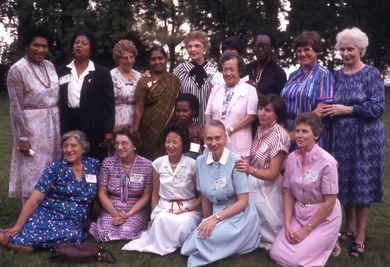 WDPIC Executive Committee, Toronto, Canada, 1984
WDPIC Executive Committee, Toronto, Canada, 1984
The basic concept for a World Meeting every 4 years and for decision making of WDPIC was: Each National Committee elects an official correspondent to the International Committee called “Liaison Officer”. The International Committee is composed of the Liaison Officers and some co-opted members. They correspond with and report to the International Committee, attend the World Meetings, and can also take votes by mail.
In this concept, the Executive Committee received a crucial role. Its 6 members should come from different geographical areas and carry on most of the actual work together with the Administrative Secretary and in cooperation with the National Committees. They are elected at the International Committee Meetings and may or may not be National Representatives. The Rules give detailed descriptions for tasks and how responsibilities are divided up between Executive Committee and National Committees.
The Executive Committee elected in Vallingby also represented different denominations and age groups. The members came from Africa (Sierra Leone), Asia (Japan), Europe (Germany, Chairperson of the Executive Committee), Latin America (Guyana), Middle East (Lebanon) and North America (Canada). The Alternates, which were chosen to substitute for them, were from South Africa, Indonesia, Italy, Mexico, Australia and USA.
Not all decisions of Vallingby can be listed here. However, the decision that the member from Switzerland should represent the International Committee in discussions with the World Union of Catholic Women’s Organizations, together with the Executive Committee, needs to be mentioned because it would soon become very significant.
The next Meeting of the International Committee for World Day of Prayer was to be held in Bangkok, Thailand, in September 1970, following the East Asian Women’s Conference. The location would allow especially Asian women to participate, besides the Executive Committee and representatives of all other National Committees who could afford the expenses.
In this concept, the Executive Committee received a crucial role. Its 6 members should come from different geographical areas and carry on most of the actual work together with the Administrative Secretary and in cooperation with the National Committees. They are elected at the International Committee Meetings and may or may not be National Representatives. The Rules give detailed descriptions for tasks and how responsibilities are divided up between Executive Committee and National Committees.
The Executive Committee elected in Vallingby also represented different denominations and age groups. The members came from Africa (Sierra Leone), Asia (Japan), Europe (Germany, Chairperson of the Executive Committee), Latin America (Guyana), Middle East (Lebanon) and North America (Canada). The Alternates, which were chosen to substitute for them, were from South Africa, Indonesia, Italy, Mexico, Australia and USA.
Not all decisions of Vallingby can be listed here. However, the decision that the member from Switzerland should represent the International Committee in discussions with the World Union of Catholic Women’s Organizations, together with the Executive Committee, needs to be mentioned because it would soon become very significant.
The next Meeting of the International Committee for World Day of Prayer was to be held in Bangkok, Thailand, in September 1970, following the East Asian Women’s Conference. The location would allow especially Asian women to participate, besides the Executive Committee and representatives of all other National Committees who could afford the expenses.
1969/1970 World Union of Catholic Women’s Organizations Officially Cooperates with ICWDP
Two Catholic Women are Co-opted to the WDP Executive Committee
In 1969, following up the Ecumenical Conference in Taizé and listening to the many voices of Catholic women from the grassroots and from the national level who had participated in WDP services and had joined WDP groups, WUCWO decided to move its own WUCWO Day from March 25 into May and to encourage all Roman-Catholic women to take part in WDP-services on the first Friday in March so this day would become a day of worldwide ecumenical prayer and solidarity. In September 1969 the President of WUCWO wrote to the Chairperson of the Executive Committee: “Through you, I would like to inform your International Committee, that WUCWO would be very happy to be associated with you in this annual celebration”. Thus WUCWO responded to the strong movement at the grassroots with great wisdom and ecumenical vision. In 1970, in Bangkok, WDPIC decided to invite WUCWO to delegate two women to be members of the Executive Committee, and thus represent the second major Christian tradition.
Looking Back to 1968: What Do the Historical Records Reveal?
From the very beginning, women understood that their faith in Jesus Christ motivated and empowered them to find ways for local communities to pray and act together. Beginning with the women’s missionary societies, women were encouraged to become informed, to value their own contributions, to understand that prayer and action were interconnected, that justice and compassion were essential to world peace and that resources were meant to be shared. Women insisted on integrity: denominational divisions in their local communities needed to be healed and so too, did other kinds of division. Thus they reached out across denominational lines, geographic boundaries, institutional opposition; they sought to overcome racism and ethnic prejudices. Their progress was step-by-step, building relationships with one another and among their organizations. They strived for more inclusive and diverse committees.
The women of WDP always kept their focus on engaging and serving the local communities; it was a mutual interdependence. Thus thousands of local communities became centers of lived ecumenism. World Day of Prayer became a vibrant, creative time of public communal prayer taking up a worship service prepared by far away sisters. The first Friday of March became a window to the world where communities stretched to learn about distant and unfamiliar contexts and their problems, strengths, cultural enrichments. In the hands of thousands of women, local groups built structures that kept enlarging: local moved to regional, then to national and finally to international structures.
In 1967, Catholic and Protestant women were attentive to opportunities for closer collaboration as an outcome of the Second Vatican Council and thus convened the international and ecumenical meeting in Taizé. This was followed by a Consultation on International Relations with 125 women from 42 countries that took place in Anderson, Indiana, USA. While the Taizé meeting lay down the foundation for the increased ecumenical participation of Catholic women, the Anderson Meeting articulated key principles and best practices for the World Day of Prayer on national and international levels, and for increased attention to bible studies and the importance of understanding the various contexts in a worldwide movement.
These preliminary meetings forged the way for the founding of the International Committee for World Day of Prayer at Vallingby. The outcome of this meeting furthered the formation of WDP National Committees by establishing criteria for such committees. They shaped the framework for an Executive Committee, identifying regions (6 at that time) and a Chairperson. They worked out the eligibility for attendance at meetings and the voting methods for decision-making.
In 1967, Catholic and Protestant women were attentive to opportunities for closer collaboration as an outcome of the Second Vatican Council and thus convened the international and ecumenical meeting in Taizé. This was followed by a Consultation on International Relations with 125 women from 42 countries that took place in Anderson, Indiana, USA. While the Taizé meeting lay down the foundation for the increased ecumenical participation of Catholic women, the Anderson Meeting articulated key principles and best practices for the World Day of Prayer on national and international levels, and for increased attention to bible studies and the importance of understanding the various contexts in a worldwide movement.
These preliminary meetings forged the way for the founding of the International Committee for World Day of Prayer at Vallingby. The outcome of this meeting furthered the formation of WDP National Committees by establishing criteria for such committees. They shaped the framework for an Executive Committee, identifying regions (6 at that time) and a Chairperson. They worked out the eligibility for attendance at meetings and the voting methods for decision-making.
The World Day of Prayer International Committee Today
|
Over the fifty years since 1968, their fundamental principles have been fine-tuned and adjusted to current realities. The name was changed so that World of Prayer was first and International Committee was second. By 1995 WDPIC was legally incorporated according to the laws of New York State, where the office is located.
This diagram visualizes using concentric circles what is the current framework of the WDP International Committee: The beating heart of WDP is the network of local women and their local WDP ecumenical groups. These local groups are connected to their National WDP Committees.
|
The National Committees are comprised of women from Protestant, Catholic and Orthodox traditions, and ecumenical organization and are multiracial, multi-ethnic representing the composition of their respective societies. Each national committee is responsible for the translation and distribution of the WDP worship service and educational materials to their local WDP groups.
They receive the offering from the local committees and allocate it to support projects and to cover the costs for the organizing at a national and international level. There is an elected Liaison Person for each national committee and she is the person for communicating on behalf of her national committee within the region and to the WDPIC office. In this way each National Committee relates within their region, sharing information and support, and with the WDPC office, sending in their annual report and financial support. The outer most circle encompasses all the inner levels and thus all together they form the WDP International Committee. Starting at the inner core we name four avenues of international coordination:
|
Summary
 Youth Delegates at Bahamas Workshop, 2011
Youth Delegates at Bahamas Workshop, 2011
The practice for ecumenical collaboration on the local level for preparing and conducting a public ecumenical worship that engaged many people, women, men and children, became the basis for expanding levels of coordination. The international committee that was formed in Vallingby in 1968 was the fulfillment of their vision for in-person, face-to-face international collaboration. The lived ecumenical local experience could now continue up to the international level. The responsibility for the World Day of Prayer service was fully interconnected: local to national to international and back to national to local.
The vision of the women had persisted through a global economic collapse in the 1930s and two world wars. There were many intermediate steps, setbacks, frustrations, oppositions, constraints caused by limited financial resources, and sexism in society. However, the women of WDP showed that their faith in Jesus Christ, expressed in prayer that was conducted in public worship and linked to action carried them through to the formation of an international committee. When we remember them, we find strength to continue in our efforts and hope to find fresh expression of our legacy each year into the future.
The vision of the women had persisted through a global economic collapse in the 1930s and two world wars. There were many intermediate steps, setbacks, frustrations, oppositions, constraints caused by limited financial resources, and sexism in society. However, the women of WDP showed that their faith in Jesus Christ, expressed in prayer that was conducted in public worship and linked to action carried them through to the formation of an international committee. When we remember them, we find strength to continue in our efforts and hope to find fresh expression of our legacy each year into the future.
“God gave hope a sister; her name is memory.”
About the Authors
|
Dr. Helga Hiller, Former Liaison Person of the German WDP Committee and European member of the WDP Executive Committee, author of the book "Ökumene der Frauen. Anfänge und frühe Geschichte der Weltgebetstagsbewegung in den USA, weltweit und in Deutschland" [“Ecumenism of Women. Beginnings and early history of the World Day of Prayer Movement in the USA, worldwide and in Germany.”] 1999, reprinted 2006.
|
Eileen King, WDPIC Executive Director 1987 to 2012, now retired and doing volunteer work on affordable housing in New York City. Between 1997 and 1998, they visited archives of denominational women’s organizations, Church Women United, the National Council of Churches of USA, and the Foreign and Home Missionary Societies in order to make copies of primary sources, which are filed in the WDPIC office, and which also relate to the period covered in this article
|
*All photos were selected by the authors from their archives.
|
| ||||
| Die Geschichte des Internationalen Weltgebetstags Komitees |

